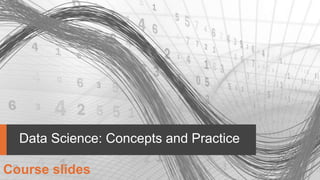
01. Introduction.pptx
- 1. Data Science: Concepts and Practice Course slides
- 2. Data Science: Concepts and Practice Authors : Vijay Kotu & Bala Deshpande Publisher : Morgan Kaufmann Course Book Course Software www.rapidminer.com Free Download
- 4. What is Data Science
- 5. Models
- 7. Types of Data Science
- 8. Tasks Description Algorithms Examples Classification Predict if a data point belongs to one of predefined classes. The prediction will be based on learning from known data set. Decision Trees, Neural networks, Bayesian models, Induction rules, K nearest neighbors Assigning voters into known buckets by political parties eg: soccer moms. Bucketing new customers into one of known customer groups. Regression Predict the numeric target label of a data point. The prediction will be based on learning from known data set. Linear regression, Logistic regression Predicting unemployment rate for next year. Estimating insurance premium. Anomaly detection Predict if a data point is an outlier compared to other data points in the data set. Distance based, Density based, LOF Fraud transaction detection in credit cards. Network intrusion detection. Time series Predict if the value of the target variable for future time frame based on history values. Exponential smoothing, ARIMA, regression Sales forecasting, production forecasting, virtually any growth phenomenon that needs to be extrapolated Clustering Identify natural clusters within the data set based on inherit properties within the data set. K means, density based clustering - DBSCAN Finding customer segments in a company based on transaction, web and customer call data. Association analysis Identify relationships within an itemset based on transaction data. FP Growth, Apriori Find cross selling opportunities for a retailor based on transaction purchase history.
- 9. Course outline Data Science Process Data Exploration Model Evaluation Classification Decision Trees Rule Induction k-Nearest Neighbors Naïve Bayesian Artificial Neural Networks Support Vector Machines Ensemble Learners Regression Linear Regression Logistic Regression Association Analysis Apriori FP-Growth Clustering k-Means DBSCAN Self-Organizing Maps Text Mining Time Series Forecasting Anomaly Detection Feature Selection Process Basics Core Algorithms Common Applications